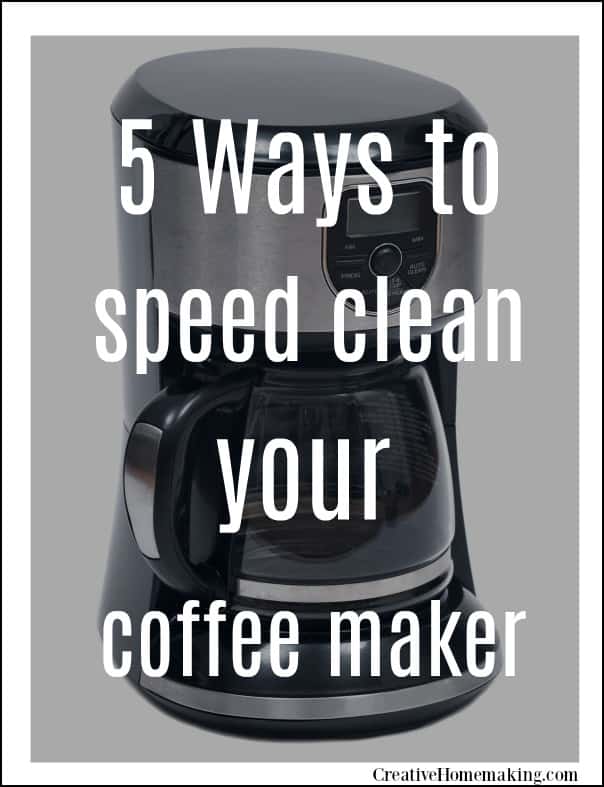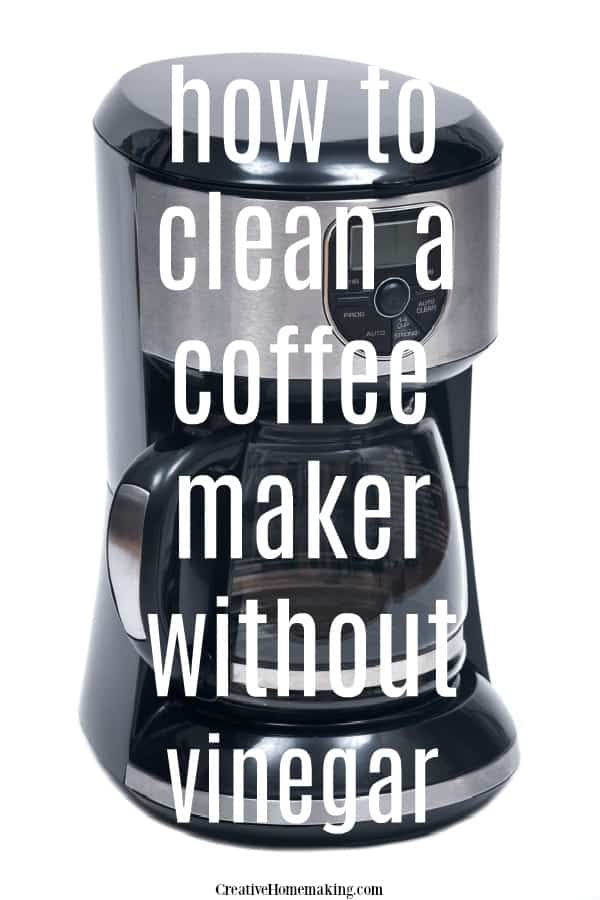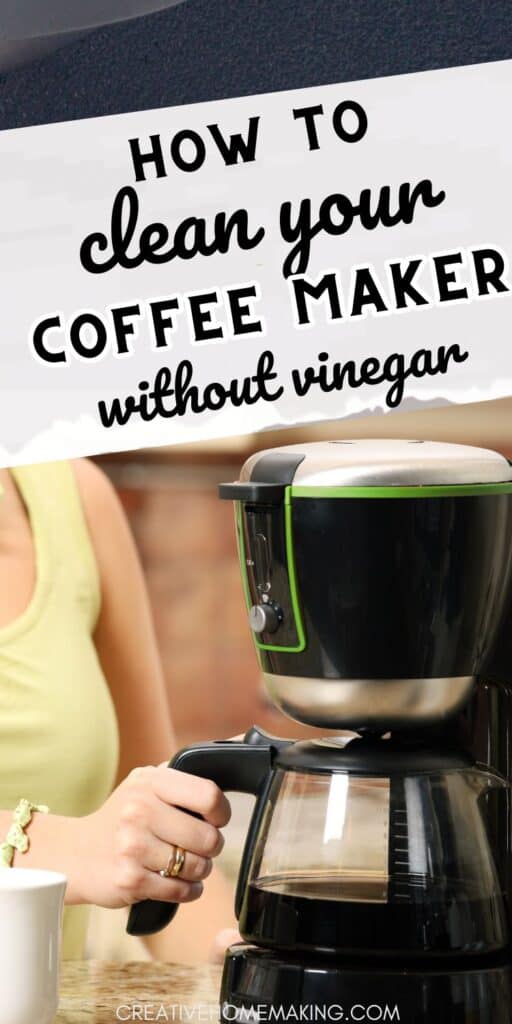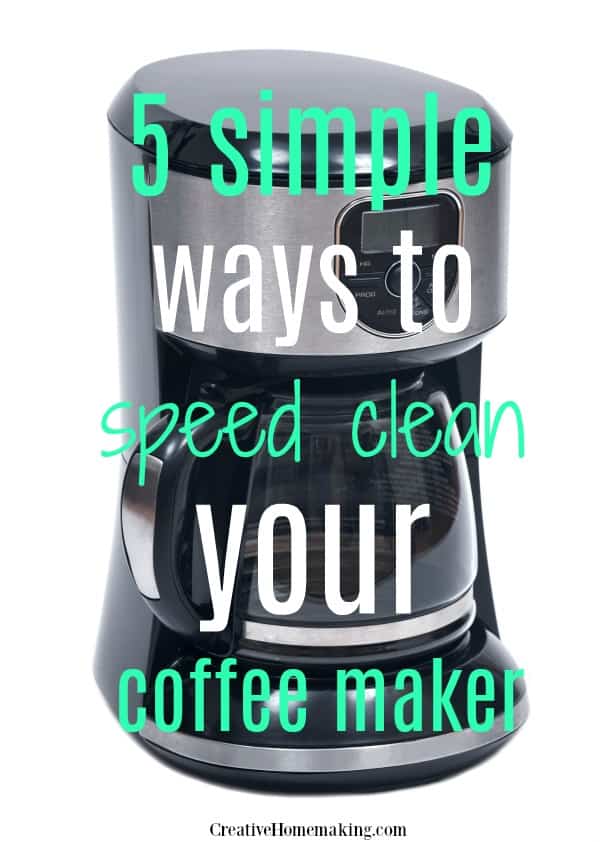If you’re an avid coffee drinker, you know how important it is to keep your coffee maker clean. Over time, your coffee maker can accumulate mineral build-up and leftover coffee oils, which can affect the taste and quality of your brew.
This post may contain affiliate links.
While many people turn to vinegar as a go-to cleaning solution, not everyone wants to use it. Fortunately, there are several effective ways to clean your coffee maker without vinegar.
One option is to use baking soda. Baking soda is a natural cleaning agent that can help remove stains and odors from your coffee maker. Simply mix a quarter cup of baking soda with a cup of water and run it through your coffee maker like you would with vinegar.
Another option is to use citric acid, which is a common ingredient in many cleaning products. You can buy citric acid powder online or at your local grocery store, and mix it with water to create a cleaning solution.
Understanding Your Coffee Maker
Before you dive into cleaning your coffee maker, it’s important to understand how it works and what common issues you may encounter. This will help you to identify any potential problems and take preventative measures to keep your coffee maker running smoothly.
Types of Coffee Makers
There are several types of coffee makers on the market, each with its own unique features and maintenance requirements. Some of the most common types include drip coffee makers, single-serve coffee makers, and espresso machines.
Drip coffee makers are the most popular type of coffee maker and are typically the easiest to clean.
Single-serve coffee makers, such as Keurig machines, require more frequent cleaning due to their smaller size and more complex brewing process. Espresso machines are the most complex and require the most maintenance, but they also produce the highest quality coffee.
Common Issues with Coffee Makers
Regardless of the type of coffee maker you have, there are a few common issues that you may encounter. These include:
- Buildup of minerals and oils: Over time, minerals and oils from the coffee beans can build up in your coffee maker, leading to a bitter taste and decreased performance.
- Clogs in the brewing system: If your coffee maker becomes clogged, it may not be able to brew properly, resulting in weak or bitter coffee.
- Mold and bacteria growth: If you don’t clean your coffee maker regularly, mold and bacteria can grow inside, which can be harmful to your health.
By understanding these common issues, you can take steps to prevent them from occurring and keep your coffee maker in top condition. Regular maintenance is key to ensuring that your coffee maker produces delicious coffee every time.

Preparation for Cleaning
Before you start cleaning your coffee maker without vinegar, it’s important to gather all the necessary supplies and take some safety precautions.
Gathering Alternative Cleaning Supplies
There are many alternatives to vinegar that you can use to clean your coffee maker. Some of the most effective alternatives include lemon juice, baking soda, dish soap, hydrogen peroxide, borax, alcohol, vodka, citric acid, and cream of tartar.
Lemon juice is a natural acid that can effectively remove mineral buildup inside your coffee maker. Baking soda is a gentle abrasive that can remove stains and odors. Dish soap is a powerful degreaser that can remove coffee oils and residue.
Hydrogen peroxide is a natural disinfectant that can kill bacteria and germs. Borax is a natural cleaner that can remove tough stains and odors. Alcohol and vodka are effective at dissolving oils and removing stains. Citric acid is a natural acid that can remove mineral buildup and stains. Cream of tartar is a gentle abrasive that can remove stains and odors.
Safety Precautions
When cleaning your coffee maker, it’s important to take some safety precautions to avoid accidents and injuries. Here are some safety tips to keep in mind:
- Unplug your coffee maker before cleaning it.
- Let your coffee maker cool down before cleaning it.
- Use gloves to protect your hands from hot water and cleaning solutions.
- Read the labels of your cleaning supplies to make sure they are safe to use on your coffee maker.
- Don’t mix different cleaning solutions together, as they can create harmful fumes.
- Rinse your coffee maker thoroughly after cleaning it to remove any cleaning solution residue.
By following these preparation steps, you can effectively clean your coffee maker without vinegar and enjoy a fresh and flavorful cup of coffee every time.

Cleaning Process
If you want to clean your coffee maker without using vinegar, follow this step-by-step cleaning guide:
Step-by-Step Cleaning Guide
- First, unplug your coffee maker and let it cool down completely.
- Remove any used coffee grounds or filters from the coffee maker.
- Fill the water reservoir with a mixture of equal parts water and lemon juice.
- Turn on the coffee maker and run it through a normal brewing cycle.
- Once the brewing cycle is complete, turn off the coffee maker and let the lemon juice mixture sit in the carafe for 15-20 minutes.
- After the 15-20 minutes, dump the lemon juice mixture out of the carafe and rinse it with warm water.
Rinsing and Drying
To ensure that your coffee maker is free of any remaining lemon juice mixture, rinse it out with warm water several times. Then, let it air dry completely before using it again.
Cleaning your coffee maker without vinegar can help remove stains, bacteria, mold, germs, coffee residue, mineral deposits, and sanitize your coffee maker. By following this easy and friendly cleaning process, you can have a clean coffee maker that will continue to make delicious coffee for you to enjoy.
Natural Cleaning Agents
If you’re not a fan of using vinegar to clean your coffee maker, there are plenty of natural alternatives that can be just as effective. Here are some options to consider:
Lemon Juice and Water Solution
Lemon juice is a natural acid that can help to break down any buildup in your coffee maker. Mix equal parts lemon juice and water and pour the solution into the water reservoir.
Run the coffee maker as you normally would, but without any coffee grounds. Once the cycle is complete, run the coffee maker again with just water to rinse out any remaining lemon juice.
Baking Soda Solution
Baking soda is another natural cleaning agent that can be used to clean your coffee maker. Mix 1/4 cup of baking soda with 1 quart of water and pour the solution into the water reservoir.
Run the coffee maker as you normally would, but without any coffee grounds. Once the cycle is complete, run the coffee maker again with just water to rinse out any remaining baking soda.
Diluted Hydrogen Peroxide
Hydrogen peroxide is a natural disinfectant that can help to kill any bacteria in your coffee maker. Mix equal parts hydrogen peroxide and water and pour the solution into the water reservoir.
Run the coffee maker as you normally would, but without any coffee grounds. Once the cycle is complete, run the coffee maker again with just water to rinse out any remaining hydrogen peroxide.
Dish Soap and Water
Dish soap is a great option if you’re looking for a quick and easy way to clean your coffee maker. Mix a small amount of dish soap with water and pour the solution into the water reservoir.
Run the coffee maker as you normally would, but without any coffee grounds. Once the cycle is complete, run the coffee maker again with just water to rinse out any remaining dish soap.
Remember to always rinse your coffee maker thoroughly after using any of these natural cleaning agents. Additionally, it’s important to note that lemon juice and vinegar are both acidic, while baking soda is alkaline.
Understanding the acidity or alkaline properties of these natural cleaning agents can help you choose the best option for your coffee maker.
Descaling Your Coffee Maker
If you’re noticing a change in the taste of your coffee or your coffee maker is taking longer to brew, it might be time to descale your coffee maker.
Descaling is the process of removing mineral deposits that build up over time in your coffee maker. Here are some tips on how to descale your coffee maker without vinegar.
Identifying Mineral Build-up
Mineral build-up can be identified by the white or brownish stains that appear on the coffee maker. These stains are caused by the minerals in your water, such as calcium and magnesium, which can accumulate over time and affect the taste of your coffee.
Descaling Solutions
There are several descaling solutions that you can use to clean your coffee maker. One option is to use citric acid, which is a natural cleaner that can effectively remove mineral deposits. Simply mix one tablespoon of citric acid with one cup of water and run the solution through your coffee maker.
Another option is to use Alka-Seltzer. This product is specifically designed to remove mineral build-up and can be found at most grocery or hardware stores. Follow the instructions on the package for best results.
If you prefer a natural solution, you can use apple cider vinegar. Mix one part apple cider vinegar with two parts water and run the solution through your coffee maker. Be sure to rinse your coffee maker thoroughly with water after using apple cider vinegar to avoid any lingering taste.
By descaling your coffee maker regularly, you can ensure that your coffee tastes fresh and delicious every time.
Special Considerations
When cleaning your coffee maker without vinegar, there are a few special considerations to keep in mind. Depending on the type of coffee maker you have, there may be different methods or steps to follow. Here are some tips for cleaning single-serve coffee makers and espresso machines.
For Single-Serve Coffee Makers
If you have a single-serve coffee maker, such as a Keurig, you’ll want to be especially careful when cleaning it. These machines can be prone to clogs and buildup, so it’s important to clean them regularly to keep them running smoothly.
One option for cleaning a single-serve coffee maker is to use a mixture of water and baking soda. Simply mix one cup of water with one tablespoon of baking soda and run it through your coffee maker. Be sure to run a few cycles of plain water afterwards to rinse out any remaining residue.
Another option is to use a specialized cleaning solution designed for single-serve coffee makers. These can be found at most home goods stores or online. Follow the instructions on the package carefully to ensure that you’re using the product correctly.
For Espresso Machines
If you have an espresso machine, you’ll want to take extra care when cleaning it. These machines can be quite complex, and it’s important to follow the manufacturer’s instructions carefully to avoid damaging the machine.
One option for cleaning an espresso machine is to use a mixture of water and citric acid. Citric acid is a natural cleaning agent that can help to dissolve mineral buildup and other residue.
Simply mix one tablespoon of citric acid with one cup of water and run it through your machine. Be sure to run a few cycles of plain water afterwards to rinse out any remaining residue.
Another option is to use a specialized cleaning solution designed for espresso machines. These can be found at most home goods stores or online. Follow the instructions on the package carefully to ensure that you’re using the product correctly.
No matter what type of coffee maker you have, it’s important to clean it regularly to keep it running smoothly and producing delicious coffee. By following these tips and using the right cleaning products, you can ensure that your coffee maker stays in top condition for years to come.
Maintaining a Clean Coffee Maker
Keeping your coffee maker clean is crucial to ensuring that your coffee tastes great every time. Not only does regular cleaning help to remove any buildup of coffee oils and residue, but it also helps to prevent the growth of bacteria that can cause a strong, pungent smell in your coffee maker.
Regular Cleaning Schedule
To maintain a clean coffee maker, it is recommended that you clean it at least once a month. However, if you use your coffee maker daily, you may want to clean it more frequently. Here are some steps to follow for regular cleaning:
- Begin by unplugging your coffee maker and allowing it to cool down.
- Remove the filter and any remaining coffee grounds.
- Wash the carafe and filter basket in warm, soapy water, rinse thoroughly, and dry.
- Mix a solution of equal parts water and white vinegar.
- Pour the solution into the water reservoir and turn on the coffee maker.
- Allow the solution to brew halfway, then turn off the coffee maker and let it sit for 30 minutes.
- Turn the coffee maker back on and allow the solution to finish brewing.
- Discard the solution and run a cycle of clean water through the coffee maker to rinse it out.
Best Practices for Coffee Maker Care
In addition to regular cleaning, there are some best practices you can follow to keep your coffee maker in top condition:
- Use high-quality, freshly roasted coffee beans to prevent the buildup of oils and residue.
- Use filtered water to prevent the buildup of minerals and other impurities.
- Empty the carafe and remove the filter basket after each use to prevent the growth of bacteria.
- Wipe down the exterior of the coffee maker with a damp cloth to remove any spills or stains.
- Store your coffee maker in a dry, cool place to prevent the growth of mold and mildew.
By following these tips for maintaining a clean coffee maker, you can ensure that your coffee always tastes fresh and delicious, without any strong odors or pungent smells.
Frequently Asked Questions
What’s the best way to clean a coffee maker using lemon juice?
Lemon juice is a natural cleaning agent and can be used to clean a coffee maker. Fill the water reservoir with equal parts water and lemon juice and run the coffee maker as usual. Once the cycle is complete, run the coffee maker again with plain water to rinse out any remaining lemon juice.
Can I use dish soap to clean my coffee maker, and if so, how?
Yes, you can use dish soap to clean your coffee maker. Mix a few drops of dish soap with water and run the coffee maker as usual. Once the cycle is complete, run the coffee maker again with plain water to rinse out any remaining soap.
Is it safe to descale a coffee maker with apple cider vinegar?
Apple cider vinegar can be used to descale a coffee maker, but it is important to dilute it with water first. Mix equal parts water and apple cider vinegar and run the coffee maker as usual. Once the cycle is complete, run the coffee maker again with plain water to rinse out any remaining vinegar.
What are the steps for cleaning a coffee maker with baking soda?
Mix a few tablespoons of baking soda with water to create a paste. Apply the paste to the coffee pot and carafe and let it sit for a few minutes. Rinse the pot and carafe with water and run the coffee maker with plain water to remove any remaining baking soda.
How effective is hydrogen peroxide for cleaning a coffee machine?
Hydrogen peroxide can be effective for cleaning a coffee machine, but it is important to dilute it with water first.
Mix equal parts water and hydrogen peroxide and run the coffee maker as usual. Once the cycle is complete, run the coffee maker again with plain water to rinse out any remaining peroxide.
What are some alternatives to commercial coffee machine cleaners?
Some alternatives to commercial coffee machine cleaners include white vinegar, lemon juice, baking soda, and hydrogen peroxide. These natural cleaning agents can be just as effective as commercial cleaners and are often more affordable.
Follow my cleaning hacks board on Pinterest.





I’m still learning from you, but I’m making my way to the top as well. I certainly love reading everything that is written on your blog.Keep the tips coming. I loved it!